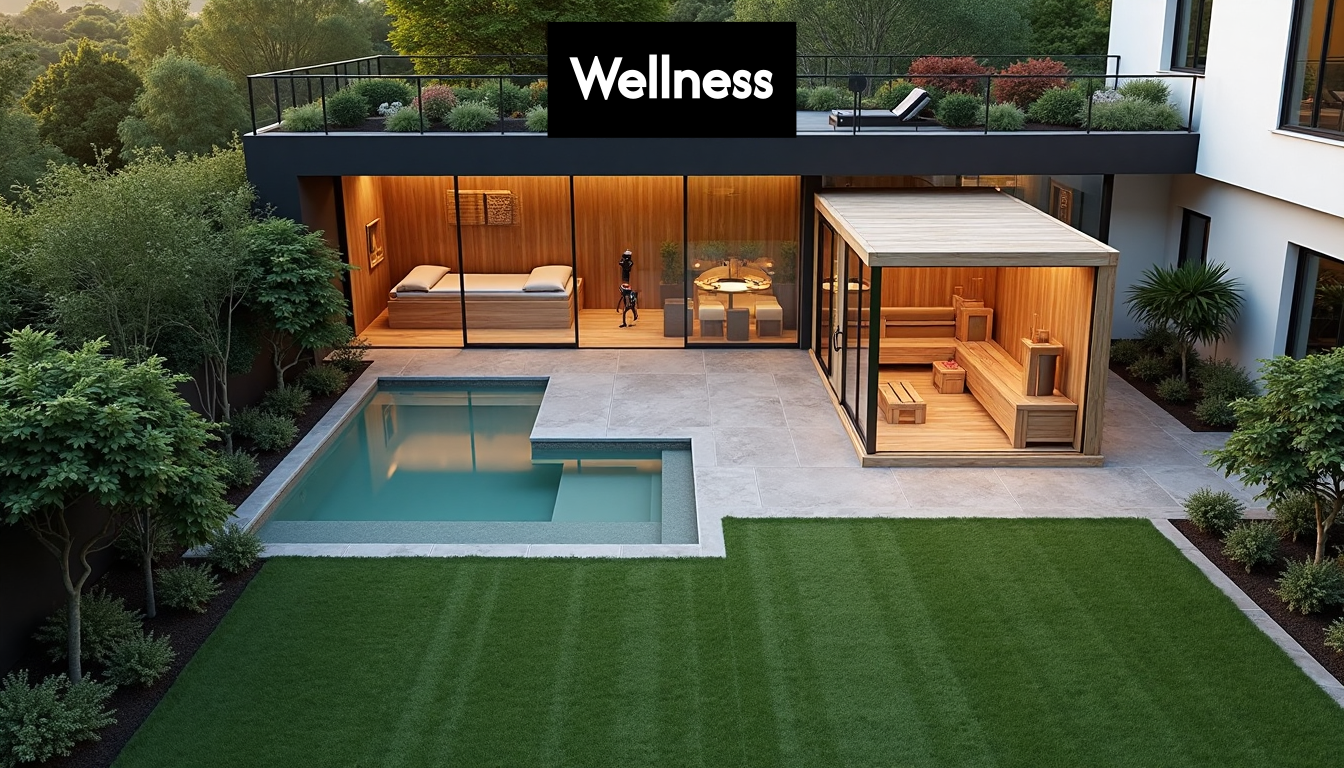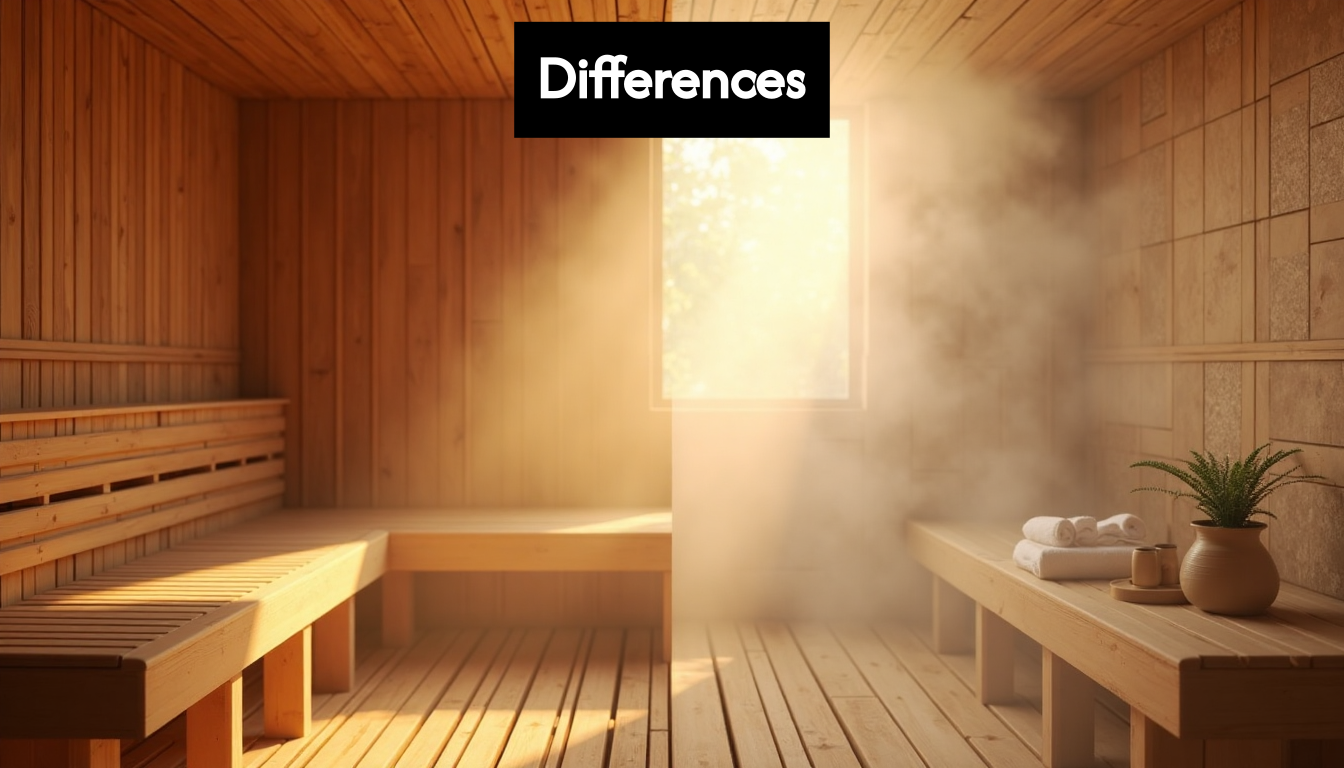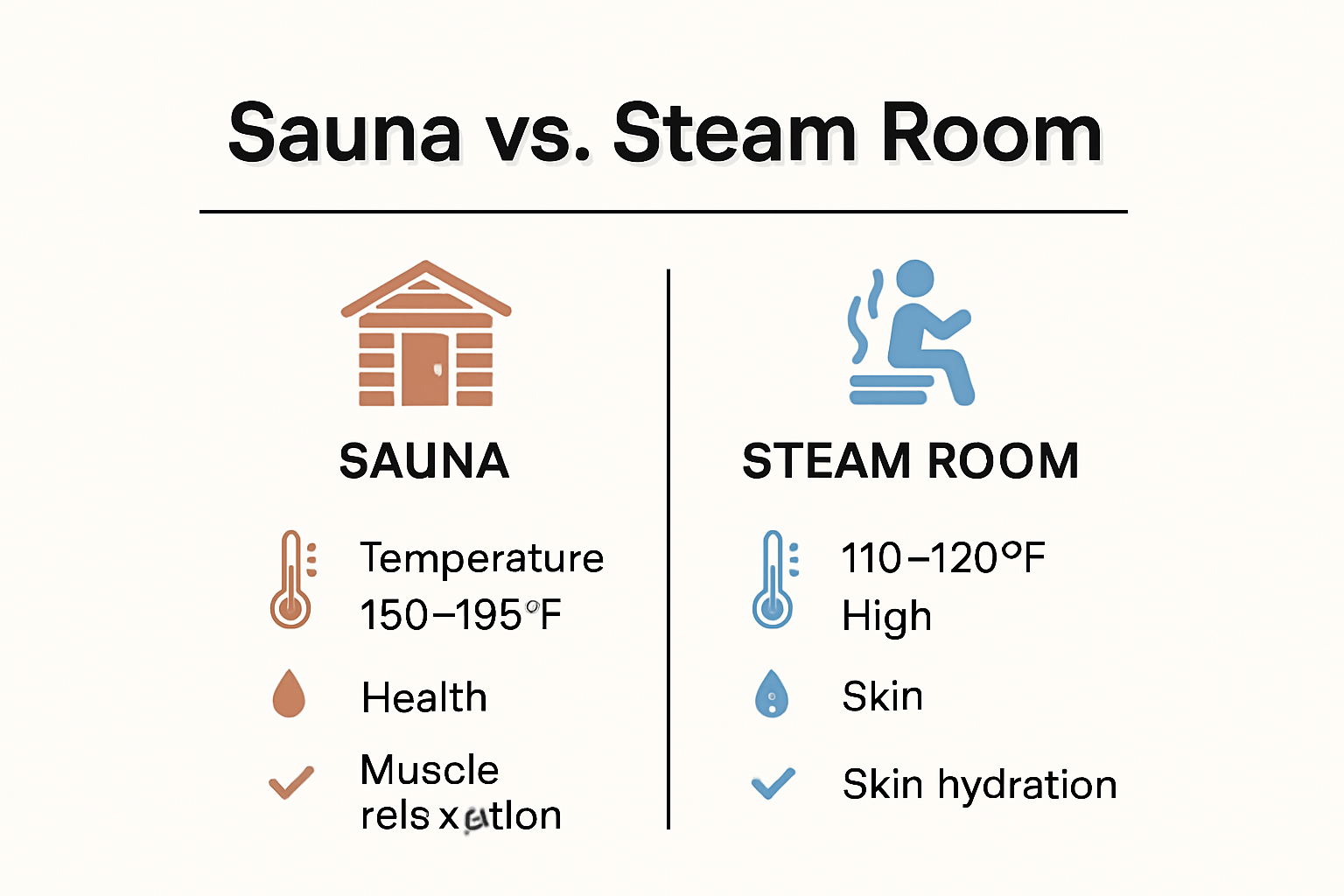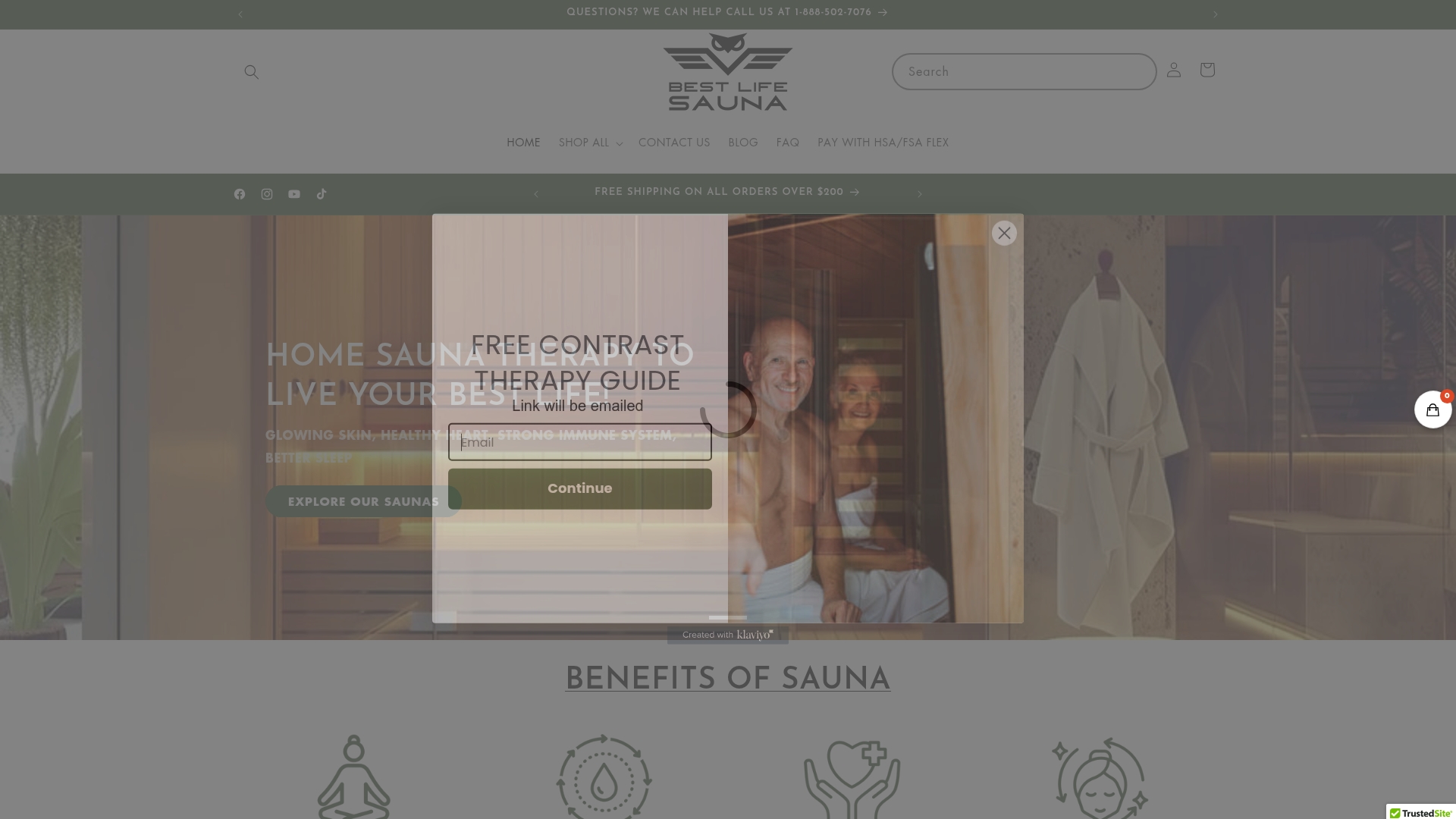
Sauna vs Steam Room: Health Benefits and Wellness Guide 2025
 Saunas and steam rooms both promise soothing heat and relaxation, but the real magic lies in the details most people miss. Most assume the higher heat in saunas means a more intense experience, yet steam rooms cloak you in nearly 100 percent humidity at cooler temperatures, creating a powerful contrast in how your body reacts. Regular sauna use can lower mortality rates by 31 percent and slash stroke risk by 62 percent, which is far more impact than most expect from a home spa ritual. If you thought these heated rooms only differed in how they make you sweat, you are in for a surprise.
Saunas and steam rooms both promise soothing heat and relaxation, but the real magic lies in the details most people miss. Most assume the higher heat in saunas means a more intense experience, yet steam rooms cloak you in nearly 100 percent humidity at cooler temperatures, creating a powerful contrast in how your body reacts. Regular sauna use can lower mortality rates by 31 percent and slash stroke risk by 62 percent, which is far more impact than most expect from a home spa ritual. If you thought these heated rooms only differed in how they make you sweat, you are in for a surprise.
Table of Contents
- Key Differences Between Sauna And Steam Room
- Health Benefits For Relaxation And Recovery
- Choosing The Right Option For Your Home
- Maintenance, Safety, And Cost Considerations
Quick Summary
| Takeaway | Explanation |
|---|---|
| Heat and Humidity Differences | Saunas provide dry heat (170°F to 195°F) with low humidity (10-20%), while steam rooms offer moist heat (110°F to 120°F) at almost 100% humidity, leading to different physiological responses. |
| Health Benefits | Saunas promote muscle recovery and cardiovascular health, while steam rooms enhance respiratory and skin health; choose based on specific wellness goals. |
| Maintenance Needs | Saunas require minimal maintenance, mostly surface cleaning, whereas steam rooms need intensive cleaning routines to manage mold and moisture issues. |
| Installation Considerations | Saunas offer flexible installation options, suitable for various spaces, while steam rooms need specialized, moisture-controlled environments. |
| Cost Factors | Steam rooms generally have higher initial and ongoing costs due to construction complexity and maintenance, while saunas are more budget-friendly options. |
Key Differences Between Sauna and Steam Room
When exploring wellness heat therapies, understanding the key differences between saunas and steam rooms becomes crucial for making an informed choice about your health and relaxation routine. While both offer therapeutic benefits, their unique characteristics create distinctly different experiences for users.
Heat and Humidity Dynamics
The fundamental difference between saunas and steam rooms lies in their heat and humidity profiles. Saunas generate intense dry heat, typically reaching temperatures between 170°F and 195°F with extremely low humidity levels of 10–20%. This environment creates a high-temperature experience where users can withstand heat through low moisture content.
Physiological and Health Benefits
Each heat therapy offers specialized benefits tailored to different wellness goals. Saunas excel in muscle recovery, cardiovascular conditioning, and promoting heat tolerance. The dry heat penetrates deeply into muscle tissue, helping to reduce inflammation, improve circulation, and support post-workout recovery. Sun Valley Saunas highlights that the intense dry heat can trigger enhanced metabolic responses and potentially support weight management efforts.
Steam rooms shine in respiratory and skin health domains. The high-humidity environment provides exceptional benefits for individuals with respiratory challenges. Moist air helps loosen mucus, clear nasal passages, and provide relief from congestion. For skin health, the steam opens pores, promotes deep hydration, and can contribute to a more radiant complexion.
Personal Comfort and Individual Preference
Choosing between a sauna and steam room ultimately depends on personal comfort, health objectives, and individual physiological responses. Some individuals find the dry heat of saunas more tolerable and enjoy the ability to breathe more easily. Others prefer the enveloping warmth and moisture of steam rooms, which can feel more gentle and soothing.
People with specific health conditions should consult healthcare professionals before incorporating either heat therapy into their wellness routine. Individuals with cardiovascular issues, respiratory conditions, or heat sensitivity might have different recommendations for which environment suits them best.
 While both saunas and steam rooms offer remarkable wellness benefits, they are not interchangeable experiences. Understanding their unique characteristics allows you to select the heat therapy that aligns most closely with your personal health goals and comfort preferences.
While both saunas and steam rooms offer remarkable wellness benefits, they are not interchangeable experiences. Understanding their unique characteristics allows you to select the heat therapy that aligns most closely with your personal health goals and comfort preferences.
 Whether you seek muscle recovery, respiratory relief, or simply a moment of relaxation, both options provide powerful pathways to enhanced physical and mental well-being.
Whether you seek muscle recovery, respiratory relief, or simply a moment of relaxation, both options provide powerful pathways to enhanced physical and mental well-being.
Health Benefits for Relaxation and Recovery
Relaxation and recovery are critical components of a holistic wellness strategy, and both saunas and steam rooms offer unique pathways to achieving mental and physical restoration. Understanding how these heat therapies contribute to overall well-being can help individuals make informed choices about their wellness routines.
Stress Reduction and Mental Wellness
Heat therapy provides profound mental health benefits by directly influencing the body’s stress response mechanisms. Healthline explains that heat exposure triggers a significant reduction in cortisol levels while simultaneously boosting endorphin production. This neurochemical shift creates a natural stress relief mechanism that promotes relaxation and improves mood.
Both saunas and steam rooms act as powerful tools for mental decompression. The immersive heat environment encourages mindfulness, helping users disconnect from daily stressors and enter a state of deep relaxation. The sensory experience of warmth enveloping the body creates a meditative state that can lower anxiety levels and promote emotional balance.
Physical Recovery and Physiological Restoration
Regular heat therapy sessions demonstrate remarkable potential for physical recovery and long-term health outcomes. Sun Valley Saunas highlights compelling research indicating that consistent sauna use is associated with significant health benefits. Individuals who engage in 4-7 weekly sessions experience a 31% lower mortality rate and a 62% reduced risk of stroke.
Steam rooms excel in immediate physical recovery, particularly for respiratory and muscular systems. The high-humidity environment provides deep hydration and helps alleviate muscle tension. Strength Warehouse notes that steam rooms are especially effective for individuals seeking quick respiratory relief, helping to clear nasal passages and reduce sinus pressure.
Holistic Wellness and Long-Term Benefits
Beyond immediate relaxation, heat therapies contribute to a comprehensive approach to wellness. Regular use supports the body’s natural healing processes, enhances circulation, and promotes cellular regeneration. The thermal stress experienced during sauna or steam room sessions triggers adaptive responses that can improve overall physiological resilience.
Individuals with chronic stress, muscle tension, or respiratory challenges may find significant relief through consistent heat therapy. However, it is crucial to approach these wellness practices mindfully. Consulting healthcare professionals can help determine the most appropriate heat therapy based on individual health conditions and personal wellness goals.
Whether you choose a sauna or steam room, the key is consistency and listening to your body. Start with shorter sessions and gradually increase duration as your body adapts. Hydration remains critical before, during, and after heat therapy to support your body’s natural recovery processes.
Ultimately, both saunas and steam rooms offer powerful pathways to relaxation and recovery. By understanding their unique benefits and integrating them thoughtfully into your wellness routine, you can unlock remarkable potential for physical restoration and mental rejuvenation.
Choosing the Right Option for Your Home
Selecting the ideal heat therapy solution for your home involves careful consideration of multiple factors beyond personal preference. Understanding the nuanced requirements for saunas and steam rooms helps homeowners make an informed investment that aligns with their wellness goals, available space, and maintenance capabilities.
Space and Installation Requirements
Home installation complexity varies significantly between saunas and steam rooms. Sauna Box highlights that saunas offer remarkable installation flexibility. You can place them indoors or outdoors, as freestanding units or integrated spaces, making them adaptable to diverse home layouts.
Steam rooms demand more specialized installation considerations. They typically require dedicated bathroom spaces or prefabricated steam shower enclosures. Critical factors include waterproof walls, precise sealing, appropriate drainage systems, and robust ventilation to prevent moisture damage. Homeowners must ensure their selected space can withstand constant high-humidity environments.
Maintenance and Long-Term Care
Maintenance requirements represent a crucial decision-making factor. Epic Hot Tubs explains that saunas generally demand minimal upkeep. Basic cleaning, occasional wood treatment, and ensuring proper ventilation constitute the primary maintenance tasks.
Steam rooms require significantly more intensive maintenance. The constant moisture creates potential challenges like mold growth, tile deterioration, and potential structural damage if not properly managed. Homeowners must commit to regular professional-grade cleaning, checking grout and seal integrity, and implementing robust moisture control strategies.
Budget and Cost Considerations
Budget plays a pivotal role in selecting your home heat therapy solution. Initial installation costs for steam rooms tend to be higher due to specialized construction requirements. Custom steam shower installations can range from $4,000 to $15,000, depending on complexity and materials.
Saunas offer more diverse price points. Prefabricated units start around $2,000, while custom indoor or outdoor installations can reach $10,000 or more. Fixr recommends considering not just upfront costs but long-term maintenance expenses when making your selection.
Beyond financial investment, evaluate your personal wellness objectives. If respiratory health and skin hydration are priorities, a steam room might offer superior benefits. For muscle recovery, cardiovascular health, and versatile placement, a sauna could be the optimal choice.
Consult with wellness professionals and home renovation experts before making a final decision. They can provide personalized recommendations based on your specific home infrastructure, health goals, and budget constraints.
Remember that the best heat therapy solution is one that seamlessly integrates into your lifestyle, supports your wellness journey, and brings consistent enjoyment. Take time to research, visit showrooms, and potentially test different options before committing to ensure you select the perfect home heat therapy experience.
Maintenance, Safety, and Cost Considerations
When integrating heat therapy solutions into your home wellness routine, understanding the nuanced maintenance, safety, and financial aspects becomes paramount. Each heat therapy option presents unique challenges and considerations that extend far beyond initial installation.
Maintenance Requirements and Challenges
Nordic Sauna highlights significant differences in maintenance between saunas and steam rooms. Dry saunas operate with low humidity levels (5-30%), making them relatively easier to maintain. Regular surface cleaning to remove sweat, oils, and dirt suffices for basic upkeep.
Steam rooms demand substantially more intensive maintenance due to their 100% humidity environment. The constant moisture creates an ideal breeding ground for mold and bacterial growth. Homeowners must implement rigorous cleaning protocols, including:
- Weekly thorough disinfection of all surfaces
- Regular grout and tile inspection
- Proper ventilation management
- Professional deep cleaning every few months
Safety Protocols and Health Considerations
Safety represents a critical factor in heat therapy experiences. Take a Break Spas emphasizes the importance of understanding material differences that impact safety. Steam rooms require non-porous materials like ceramic tiles to prevent moisture absorption and potential structural damage.
Key safety recommendations include:
- Installing proper temperature and humidity monitoring systems
- Ensuring adequate ventilation
- Using non-slip surfaces
- Maintaining recommended temperature ranges
- Providing clear emergency exit pathways
Individuals with pre-existing health conditions should consult healthcare professionals before regular use. People with cardiovascular issues, respiratory problems, or heat sensitivity require personalized guidance to ensure safe heat therapy experiences.
Financial Investment and Long-Term Considerations
The financial landscape of heat therapy solutions extends beyond initial installation costs. Saunas typically represent a more budget-friendly and low-maintenance option. Installation costs range from $3,000 to $10,000, depending on size, materials, and complexity.
Steam rooms demand higher initial and ongoing investments. Custom installations can range from $5,000 to $20,000, with additional expenses for:
- Specialized waterproofing
- Advanced ventilation systems
- Regular professional maintenance
- Potential structural modifications
Homeowners should consider not just upfront expenses but long-term operational costs. Energy consumption, maintenance frequency, and potential repair needs all contribute to the total cost of ownership.
Budget-conscious individuals might find modular or prefabricated units more economical. These options provide flexibility and reduce installation complexities while maintaining core wellness benefits.
Ultimately, selecting the right heat therapy solution requires balancing personal wellness goals, financial capabilities, and home infrastructure. Thorough research, professional consultations, and careful consideration of maintenance requirements will help you make an informed decision that supports your long-term health and lifestyle objectives.
Frequently Asked Questions
What are the main differences between a sauna and a steam room?
Saunas provide dry heat, typically between 170°F to 195°F with low humidity (10-20%), while steam rooms offer moist heat around 110°F to 120°F at nearly 100% humidity. This leads to different physiological responses and user experiences.
What health benefits can I expect from using a sauna?
Regular sauna use can lower mortality rates by 31% and reduce stroke risk by 62%. It also promotes muscle recovery, cardiovascular health, and helps with post-workout recovery.
How does a steam room benefit respiratory health?
The high humidity in steam rooms helps loosen mucus, clear nasal passages, and provides relief from congestion, making it beneficial for individuals with respiratory challenges.
Which option is better for skin health, a sauna or steam room?
Steam rooms are generally better for skin health as the moisture helps to open pores, promote hydration, and can contribute to a more radiant complexion.
Elevate Your Wellness Journey with Best Life Sauna
As you’ve learned from our comprehensive guide on saunas versus steam rooms, both heat therapies offer remarkable benefits for relaxation and recovery. However, if muscle recovery, cardiovascular health, and stress relief are at the top of your wellness goals, investing in a sauna could be your game-changer.
!
At Best Life Sauna, we specialize in premium sauna options that cater to your unique needs. With a wide selection—including infrared, traditional, and outdoor saunas—we ensure you can find just the right fit for your home. Plus, enjoy the added benefit of knowing your investment is backed by our price match guarantee and hailed by satisfied customers who have improved their wellness journeys.
Don’t wait to experience the transformative health benefits of regular sauna use. Visit us today at https://bestlifesauna.com and get free shipping on orders over $200! Your path to enhanced relaxation and vibrancy starts now!
Recommended Articles
- Why a Sauna Makes the Perfect Christmas Gift That Keeps on Giving All – Best Life SaunaBest Life Sauna - Premium Saunas for WellnessAmerican ExpressApple PayDiners ClubDiscoverGoogle PayMastercardPayPalShop PayVisa
- Embrace Wellness: Paying for Your Sauna with FLEX at Best Life Sauna Best Life Sauna - Premium Saunas for WellnessAmerican ExpressApple PayDiners ClubDiscoverGoogle PayMastercardPayPalShop PayVisa
- Best Sauna Temperature 2025: Top Tips for Health Relaxation – Best Life Sauna
- Discover the Benefits of Outdoor Saunas for Health, Relaxation & Home – Best Life SaunaBest Life Sauna - Premium Saunas for WellnessAmerican ExpressApple PayDiners ClubDiscoverGoogle PayMastercardPayPalShop PayVisa
- News – Best Life SaunaBest Life Sauna - Premium Saunas for WellnessAmerican ExpressApple PayDiners ClubDiscoverGoogle PayMastercardPayPalShop PayVisa

